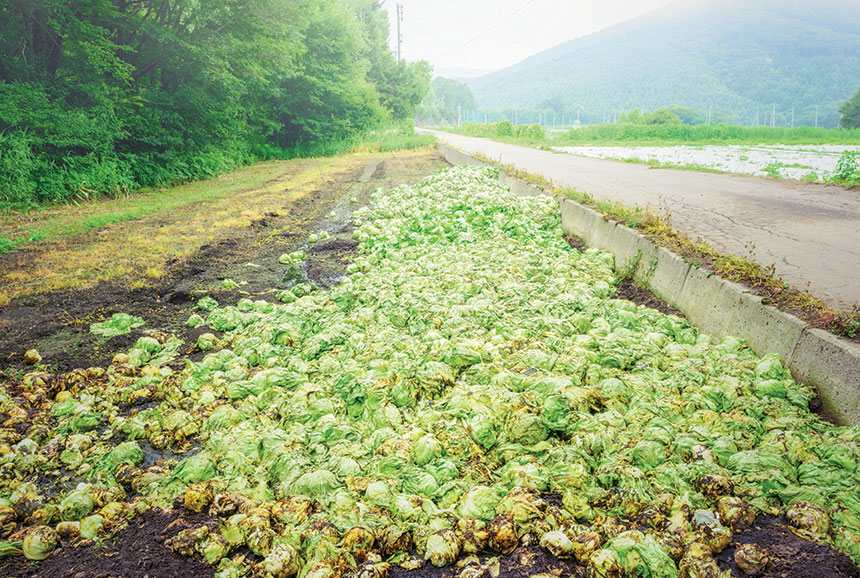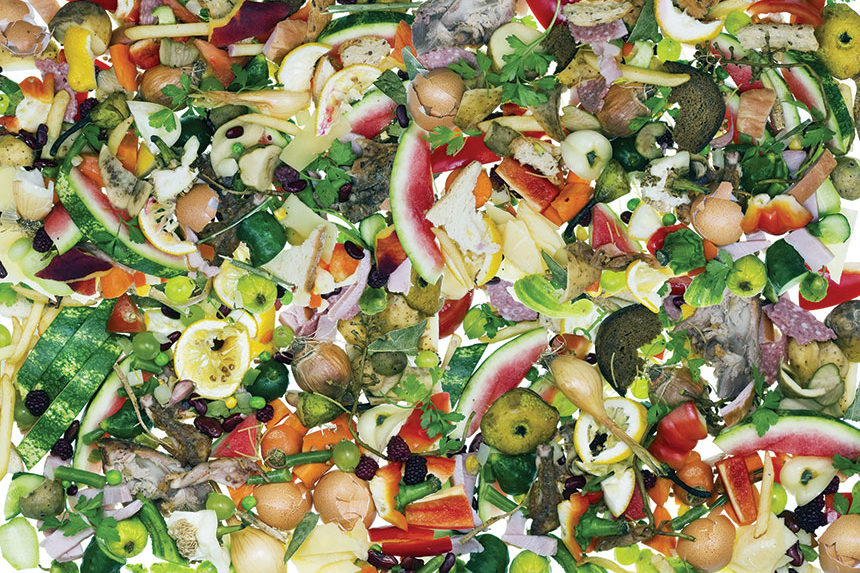It’s a drizzly March morning in Nashville, and the sky looks like the garbage dump beneath it — a vast gray-brown morass. Against this backdrop, Georgann Parker appears like a Mad Max desperado. She’s wearing safety glasses and surgical gloves, tall rubber wellies over her jeans, a bright orange vest over her jacket, and a hard hat over her cropped gray-blonde hair. “We can be glad it’s not hot,” she says, smiling behind her respiration mask. Parker is uncannily upbeat for a woman about to perform a diagnostic exercise that’s technically called a waste audit but in Kroger inner circles is referred to as a dumpster dive. Parker is Kroger Company’s corporate chief of perishable donations, a role that occasionally involves ripping into hundreds of garbage bags to manually investigate their rotting contents.
Parker has come with two Kroger employees and two officials from Waste Management, the company that collects and dumps all of Kroger’s trash. They stand and watch as a compactor truck unloads on the ground in front of them. The trash mound has been generated over the previous six days by one of 2,800 Kroger supermarkets nationwide. Kroger’s stores serve 9 million individual American shoppers per day and 60 million American families per year, more than a third of the U.S. population. Each store produces many tons of trash a week — most of it perishable fruits, vegetables, meats, dairy, and deli products that have passed their prime or reached their sell-by dates but are still safe to eat.
It’s Parker’s job to help rescue Kroger’s sizable trove of safe-but-unsellable food across its many stores. She oversees the 120 division heads nationwide who manage the company’s food rescue operations. Annually Parker and her team capture about 75 million pounds of fresh meats, produce, and baked goods before they get thrown out, and donate them to local food banks and pantries. The number is big, but it’s a fraction of Kroger’s total fresh-foods waste stream. The company has pledged to donate more than ten times that amount as part of the Zero Hunger, Zero Waste campaign it launched in 2018. The goal is to eliminate food waste from its stores by 2025, and alleviate hunger in the communities surrounding these stores in the same time frame.
“Crazy-big” is how Parker describes the scope of Kroger’s goal, “and, yeah, a little daunting. The logistics of food rescue are very complex.” For a company as big as Kroger it means not only rescuing the food before it goes bad but coordinating the donations with tens of thousands of food banks and soup kitchens across the country.
Parker, who grew up in a town in Minnesota, is that rare person who manages to come off as both effusively and effortlessly friendly. In her colorful Midwestern patois, people are “folks,” soda is “pop,” a lot of something is “a crud-load,” and excitement is often expressed as a rhetorical question: “How cool is that?” In other words, she’s a gold mine of enthusiasm about things that many of us have trouble caring about — but should.
Whether because of her chipper disposition or because she’s seen more sobering circumstances in her professional past, Parker is unfazed by the disgusting conditions at the garbage dump. Odorous methane emanates up from the depths of the landfill below; dozens of overfed vultures circle heavily in the sky above as Parker and her team paw through the mountain of waste. They find bags of potatoes and cabbages that look perfectly fresh, heads of lettuce that look less so, heaps of boxed salads and spinach, serving trays of cut fruit, countless crates of cracked eggs, dozens of meal kits filled with prepped fresh ingredients for cooking shrimp scampi and chicken à la king, packages of sliced salami and cheese, cracked bottles of tomato sauce, dented tubs of icing and ice cream, and cans of Gravy Train dog food marked “Reclaim.”
Parker and her team separate the waste into categories, weighing and photographing the contents of each. Later, they’ll crunch the numbers and find that more than half — 52 percent — of the waste produced by the supermarket could have been donated, recycled, or composted. They will assemble the data into graphs and charts with crime-scene-esque photos. “You can see which departments in the store are doing their job of food rescue, and which are not,” Parker grumbles when we discuss the results. “A lot of this should have been given a second chance.”
Fifty-two million tons of food are sent to U.S. garbage dumps annually, and another 10 million are discarded or left to rot on farms, according to Darby Hoover, a waste researcher with the San Francisco office of the environmental group Natural Resources Defense Council (NRDC). Put another way, Americans waste enough food to fill a 90,000-seat stadium every day, and that’s about 25 percent more per capita than we were wasting in the 1970s. The average American throws out more than a pound of food a day — some 400 pounds per year each. Restaurants and retailers like Kroger are close behind, generating another third of it. The value of the food wasted in America each year has been estimated at between $162 billion and $218 billion.
Hoover sees the problem from an environmental angle. “Wasting food also means wasting all the water, energy, agricultural chemicals, labor, and other resources we put into growing, processing, packaging, distributing, washing, and refrigerating it,” she observes. The nonprofit group ReFed estimates that food waste consumes 21 percent of all freshwater, 19 percent of fertilizer, 18 percent of cropland, and 21 percent of landfill volume in the United States. Add to that the methane problem: only 5 percent of food waste in America gets composted into soil fertilizer, using a controlled process in which bacteria and heat decompose food scraps into rich plant nutrients. The other 95 percent of food waste goes to landfill and rots in an uncontrolled way, emitting methane, a potent greenhouse gas. “If food waste around the world was a country, it would rank third behind China and the U.S. in terms of greenhouse gas emissions,” says Hoover.
“Wasting food becomes an ethical problem when you consider that there’s about 40 million folks in this country living on poverty.”
To Georgann Parker, the problem is a social injustice: “Wasting food — especially healthy perishables — becomes an ethical problem when you consider that there’s about 40 million folks in this country living in poverty who don’t have reliable access to nutritious food.” Less than a third of the food we’re tossing would be enough to feed this underserved population.
Kroger’s Zero Hunger, Zero Waste campaign is also a bottom-line opportunity for the company, which has to pay increasingly steep “tipping fees” — the costs imposed by some state governments on the loads of waste that a company or institution dumps. Kroger can also collect millions of dollars in federal tax breaks annually for its food donations. Pressure to cut waste is also coming from Kroger’s investors. Nearly every major brand in food retail, including Publix, Walmart, Costco, Target, and Whole Foods, has introduced waste-reduction programs in the past five years. In a recent assessment of these programs by the Center for Biological Diversity, a nonprofit based in Tucson, Arizona, Kroger was the third-highest performer in the not-very-high-performing bunch — it scored a C on the overall grading scale.
To improve that, Kroger enlisted World Wildlife Fund (WWF), which conducts a large food-waste research program (on the grounds that agriculture is the world’s biggest threat to wildlife habitat), to help the company devise a strategy for food-waste prevention and donation. WWF encouraged the dumpster dives and other rigorous waste-stream analysis. “There’s a misconception that the answer to food waste is composting,” says Pete Pearson, WWF’s director of food-waste research. “The real emphasis — whether you’re a company, or a household, or a city — needs to be on prevention first, then rescue and donation, then composting as a last resort.”
“There isn’t any waste in nature. Anything that dies in nature becomes food for something else,” Darby Hoover tells me. “Humans have created waste as a concept, and we should be able to uncreate waste as a concept.”
Hoover recently conducted a two-year study exploring and comparing food-waste patterns in three U.S. cities — Denver, New York City, and Nashville. She found the foods most often dumped in the trash or poured down the drain included brewed coffee and coffee grounds, bananas, chicken, apples, bread, oranges, potatoes, and milk. Hoover noted the conspicuous absence of things like Doritos, Spam, and Twinkies on this list. “Food waste is riddled with unexpected contradictions, and one of them is that healthier diets tend to be the most wasteful diets,” she says. “Our current cultural obsession with eating fresh foods is a great thing from a health perspective, but not so great from a waste perspective.”
She also found that parents with young kids generated waste in their efforts, however hopeful and virtuous, to expose their kids to new flavors and healthy offerings — only to have the kids refuse to eat it. The upshot: food waste at the consumer level “is often tangled up with good intentions — and that makes it particularly tricky to solve,” Hoover observes.
“Here’s where we put the uglies,” says Georgann Parker as she walks me through the produce section of a Kroger supermarket outside of Indianapolis, Indiana — one of the largest stores in the chain. I’ve come to get a crash course in supermarket logistics and a glimpse into the company’s waste-prevention efforts. I’d never noticed these particular offerings in my local Kroger before. There, tucked into the side of an island bearing those iconic pyramids of supermarket fruit — perfect orbs of red, orange, green, and yellow — is a four-tiered shelf topped with a sign “Markdown! Beauty is only skin deep.” The shelves bear mostly empty straw baskets of gnarled bell peppers, arthritic-looking carrots, too-small cantaloupes, and cucumbers curved like pistols.
While fresh produce accounts for less than 15 percent of Kroger’s profits, it’s in the company’s interest to sell every last misshapen product. “We want everything that comes in the back door to go out the front, but of course it doesn’t,” says Parker.

Kroger introduced the “uglies” section into its stores in early 2017, around the time that activists and entrepreneurs were embracing cast-off produce, and the ugly produce program works in tandem with Kroger’s regular markdown programs. If meats don’t sell within a day of their sell-by dates, they get pulled from shelves, slapped with a “WooHoo! MARK-DOWN” sticker, and placed in the sale area of the meat section. If the discounted products still don’t sell, they’re supposed to be yanked the night before their sell-by date, scanned out of the system as a loss, and put in a backroom freezer for donation. A similar process is supposed to be followed for bakery items and dairy products. The company policy is to pull milk from the dairy case ten days before its expiration date, at which point it can be donated fresh, or frozen and then thawed for donation. “There’s no good reason any milk products sold in a Kroger store should ever be dumped,” says Parker.
Confusing sell-by labeling is another major barrier to waste prevention both in supermarkets and in homes. The dates printed on perishable products you buy are not federally regulated and do not represent any technical or standardized measure of food safety. The Food and Drug Administration, which has the power to regulate date labels, has chosen not to do so because no food-safety outbreak in the United States has ever been traced to a food being consumed past date. (They’ve been traced instead to certain pathogens that may have contaminated the food during processing; or to “temperature abuse,” like leaving raw chicken in a hot car; or to air exposure that encourages mold.) “You’re far more likely to get sick from something because it’s contaminated or gone unrefrigerated than because it’s past-date,” says Parker.
“Supermarkets have to juggle dozens of different date-labeling laws, and they lose about $1 billion a year from food that expires in theory — but not in reality — before it’s sold,” says Emily Broad Leib, director of the Food Policy Program at Harvard Law School. “Date label confusion harms consumers and food companies, and it wastes massive amounts of food.” Leib helped develop the Food Date Labeling Act, proposed federal legislation that would standardize labels to “best if used by,” a phrase indicating that a product may not be optimally fresh but is still safe to eat. The bill would also incentivize public schools and government institutions to make use of ugly fruits and veggies that never make it to market.
Parker says Kroger is throwing its lobbying weight behind this while also pushing for better food packaging. Materials scientists are now finally beginning to break new ground in food packaging and preservation techniques. The challenge in preserving freshness of perishable foods comes down to sealing out oxygen. It’s a seemingly benign gas, but when it penetrates food packaging it feeds mold growth and speeds the proliferation of microorganisms and enzymes. Parker tells me that researchers are developing oxygen-absorbing films that can be incorporated into either flexible or rigid packaging materials and reduce the oxygen concentration to within less than 0.01 percent — more than doubling shelf life. The problem is cost. Food manufacturers are still packaging bread in the same plastic bags and eggs in the same cardboard cartons they’ve been using for aeons because it’s cheap.
Kroger’s investment arm is funding start-ups that are developing new packaging technologies, but in the meantime, digital tools will get ever-better at tracking the life cycle of a product from conception to sale, which will go a long way to helping supermarkets reduce their excess inventory and donate far more of it.
It’s hard to overstate how much the global food system has changed in the last 30 years, and harder still to know how and how much it will change in the decades ahead.
Innovation and ignorance got us into the mess we’ve made of our food system, and innovation combined with good judgment can get us out of it.
From The Fate of Food: What We’ll Eat in a Bigger, Hotter, Smarter World by Amanda Little, published by Harmony Books, an imprint of Random House, a division of Penguin Random House LLC. Copyright © 2019 by Amanda Little.
This article is featured in the March/April 2020 issue of The Saturday Evening Post. Subscribe to the magazine for more art, inspiring stories, fiction, humor, and features from our archives.
Featured image: Shutterstock
Become a Saturday Evening Post member and enjoy unlimited access. Subscribe now




Comments
Wow! It’s unbelievable how much we waste and yet many Americans, too damn many, continue to go hungry. Thanks to Amanda Little for diving deep into this critical issue and bringing up to the light. It inspires me to want to work for Georgann Parker at Kroger. She’s difference maker working for the betterment of us all.
I’m very impressed with the efforts of both Ms. Parker and Mr. Darby in dealing with this seemingly impossible (certainly daunting) situation.
They’re definitely on the right track and have done a lot in reversing the problem. They can’t do it alone. It’s going to take awareness and action on the parts of everyone.
Through public service announcements nationwide with what should and shouldn’t be done, the solutions to the problem should accelerate. Awareness combined with simple steps is a great start, and Kroger should be leading the way!